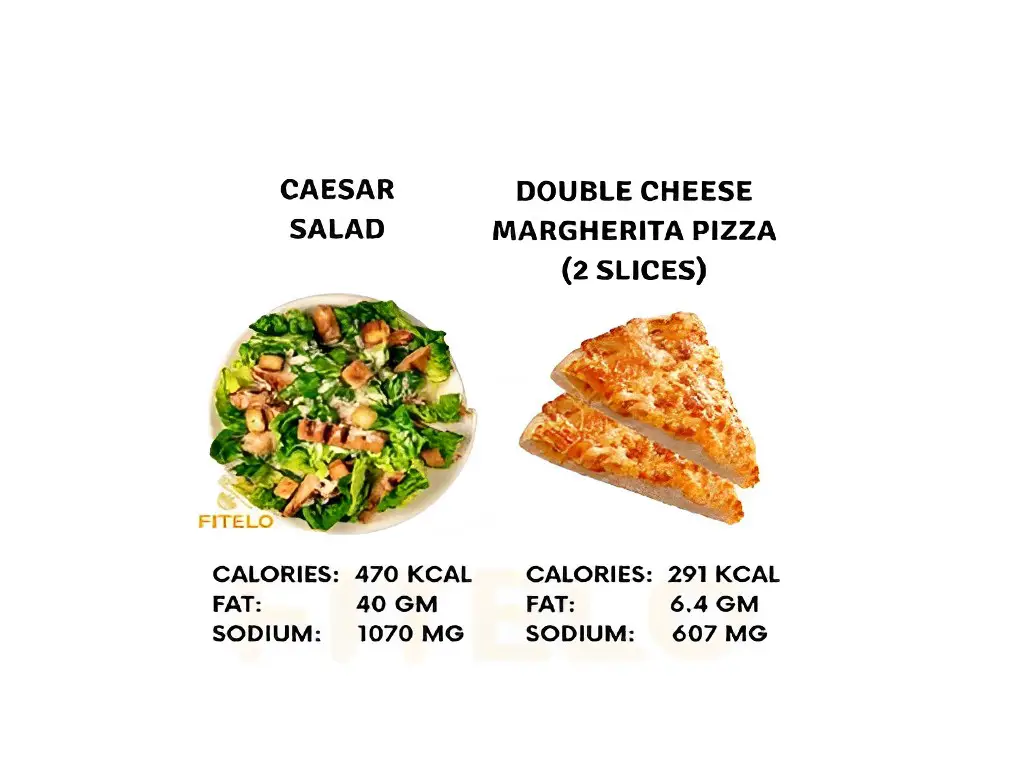Is Caesar Salad Healthy? Health Benefits and Drawbacks

Caesar salad is a classic dish that has captured many’s hearts and taste buds. The salad is known for its creamy and tangy flavors, making it a favorite choice for many salad lovers.
But is Caesar salad healthy?
Caesar salad is generally not considered healthy due to its high-calorie dressing, sodium content, and limited nutritional value. It lacks a variety of nutrients and may contain additives in store-bought dressings. However, it can be modified with low-fat options, portion control, and additional vegetables to make it healthier.
Let’s explore this beloved salad’s ingredients and nutritional aspects to find out if it deserves a place in your balanced diet.
Is Caesar Salad Healthy?
Caesar salad cannot be considered healthy primarily due to its dressing, which is high in calories, sodium, and saturated fats. The dressing alone can contain around 470 calories, 40 grams of fat, and 1070 milligrams of sodium.

Source: quora
Additionally, traditional Caesar dressing contains raw eggs, posing a risk of salmonella contamination. Although many store-bought dressings now substitute raw eggs with carrageenan, which can cause issues like bloating, irritable bowel syndrome, inflammation, and glucose intolerance.
Without the dressing, Caesar salad offers minimal nutritional value, mainly romaine lettuce, high-fat parmesan cheese, and carbohydrate-rich croutons. Therefore, considering its overall composition and potential health risks, Caesar salad is not a healthy choice.
What is in a Caesar Salad?
A Caesar Salad typically consists of romaine lettuce, croutons, and Parmesan cheese, forming its core components. Variations exist, but these ingredients remain constant. Romaine offers a refreshing, slightly bitter taste, while croutons add a satisfying crunch.
Parmesan cheese brings a rich, savory flavor to enhance the salad.
Customization is possible, with anchovies adding saltiness and umami, and chicken or bacon providing protein and texture contrast. Some swap romaine for kale or spinach, adding nutritional value, while vegetables like peppers, carrots, onions, or tomatoes introduce color and flavors.
Caesar Salads offer versatility, allowing creativity and adaptation, resulting in diverse interpretations. Chefs and home cooks can put their spin on the classic recipe, evolving and modifying it to suit their tastes.
Here is a table showing the nutritional value of Cesar salad;
| Nutrient | Caesar Salad without Dressing | Caesar Salad with Regular Dressing | Caesar Salad with Light Dressing | Caesar Salad with Chicken and Regular Dressing | Caesar Salad with Chicken and Light Dressing |
| Serving Size | 1 1/4 cups (100 grams) | 1 1/4 cups (100 grams) | 1 1/4 cups (100 grams) | 1 1/8 cups (100 grams) | 1 1/8 cups (100 grams) |
| Calories | 74 | 156 | 91 | 142 | 77 |
| Protein (grams) | 4 | 5 | 4 | 9 | 9 |
| Total Fat (grams) | 4 | 12 | 4 | 11 | 3 |
| Saturated Fat (grams) | 2 | 3 | 2 | 2 | 1 |
| Carbohydrates (grams) | 7 | 7 | 10 | 3 | 6 |
| Fiber (grams) | 2 | 2 | 2 | 3 | 2 |
| Cholesterol (milligrams) | 2 | 14 | 8 | 29 | 23 |
| Sodium (milligrams) | 225 | 407 | 286 | 444 | 434 |
| Calcium (% DV) | 9% | 9% | 9% | 5% | 5% |
| Iron (% DV) | 5% | 5% | 5% | 5% | 5% |
What is in Caesar Salad Dressing?
Caesar dressing, a vital part of a Caesar Salad, includes anchovies, garlic, olive oil, lemon juice, egg yolks, salt, and mustard. Variations exist due to personal preferences.
Chefs customize the dressing with Worcestershire sauce, mayo, Greek yogurt, or chicken broth. Anchovies can be substituted with tuna. Raw eggs are sometimes replaced with yogurt or buttermilk for safety.
Store-bought Caesar dressings may contain additional ingredients like corn syrup, sugar, xanthan gum, and modified food starch. Check labels for dietary restrictions or allergies.
Here is a table showing the nutritional value of 2 tablespoons (about 30 grams) of Caesar dressing;
| Nutrient | Regular Caesar Dressing | Light Caesar Dressing | Fat-Free Caesar Dressing |
| Calories | 163 | 30 | 45 |
| Protein (grams) | <1 | <1 | <1 |
| Total fat (grams) | 17 | 1 | <1 |
| Saturated fat (grams) | 3 | <1 | <1 |
| Carbs (grams) | 1 | 6 | 10 |
| Fiber (grams) | <1 | <1 | <1 |
| Cholesterol (mg) | 12 | 1 | <1 |
| Sodium (mg) | 363 | 344 | 428 |
| Calcium | 1% | <1% | <1% |
| Iron | 2% | <1% | <1% |
What are The Health Benefits of Caesar Salad?
The traditional Caesar salad offers several health benefits, which are given below.
1. Romaine lettuce base: Low in calories and high in fiber, aiding digestion and promoting a feeling of fullness.
2. Classic dressing: Made with olive oil, garlic, and lemon juice, providing heart-healthy fats and antioxidants.
3. Anchovies: Adds omega-3 fatty acids, which benefit brain and heart health.
4. Parmesan cheese: Provides calcium for strong bones.
5. Grilled chicken or shrimp: Adds lean protein, essential for muscle growth and repair.
Overall, enjoying a traditional Caesar salad in moderation can contribute to a nutritious meal.
What are The Drawbacks of Caesar Salad?
Caesar salad, while delicious, can pose some challenges when it comes to being considered a healthy option. Here is an in-depth discussion on why Caesar salad may not always be regarded as a healthy choice:
-
High-Calorie Content
Traditional Caesar salads can be calorie-dense, mainly due to the dressing, croutons, and cheese. The creamy sauce, often made with ingredients like egg yolks and olive oil, can be high in fat and calories.
Additionally, the presence of croutons and generous amounts of Parmesan cheese further adds to the calorie count.
-
Fat Content
Caesar dressing typically contains ingredients like olive oil and egg yolks, which contribute to its rich and creamy texture. While these fats can be a part of a balanced diet, they are high in calories and should be consumed in moderation.
Moreover, store-bought Caesar dressings may include additional unhealthy fats, such as hydrogenated oils or trans fats, which should be avoided for optimal health.
-
Sodium Content
Caesar salad dressings, anchovies, and Parmesan cheese all tend to be high in sodium. Excessive sodium intake can lead to increased blood pressure and other health issues. For individuals with hypertension or who are trying to limit their sodium intake, Caesar salad may not be the best choice, especially if consumed frequently.
-
Limited Nutrient Variety
While Caesar salads usually contain lettuce as a base, they often lack a diverse range of vegetables and nutrients. Relying heavily on romaine lettuce alone may not provide the full spectrum of vitamins, minerals, and antioxidants that a more varied salad would offer.
-
Additives in Store-Bought Dressings
Store-bought Caesar dressings can contain various additives, preservatives, and sweeteners to enhance flavor, texture, and shelf life. These additives may include high fructose corn syrup, sugar, artificial flavors, and stabilizers. Reading labels and selecting dressings with minimal additives is essential for those concerned about their overall health.
Can Individuals With Heart Conditions or Overweight Concerns Eat Caesar Salad?
Individuals with heart conditions or overweight concerns can still enjoy Caesar salad by making some modifications. They should opt for a healthier version by using low-fat dressing, reducing or omitting high-fat ingredients.
Additionally, portion control is crucial, as excessive consumption of high-calorie ingredients can impact weight and heart health. Consulting with a healthcare professional or nutritionist is recommended to tailor the salad to individual needs.
How to Make Caesar Salad Healthier?

Graphics Credit: Robustalive.com
Turn your Caesar salad into a nourishing dish by adding wholesome ingredients and making mindful choices for your well-being. Follow these tips.
- Enhancing the nutritional value: Reduce the dressing amount or mix it with Greek yogurt for extra protein. Swap out croutons for nutrient-dense toppings such as nuts or seeds. Opt for a bag of mixed greens or incorporate other veggies into your salad for added variety.
- Load up on vegetables: Include tomatoes, baby lettuces, cucumbers, radishes, and other veggies for added nutrients, fiber, and low-calorie content.
- Add a protein source: Choose lean protein options such as chicken breast, beans or legumes, nuts and seeds, salmon, shrimp, shellfish, tofu, or tempeh for a more satisfying salad.
- Make homemade croutons or use alternative toppings: Create your own croutons with whole-grain bread and olive oil, or try roasted chickpeas or nuts as crunchy alternatives.
- Use dressing in moderation: Stick to about 1 tablespoon (14 grams) of dressing per 1 1/2–2 cups (375–500 mL) serving of salad. Consider adding a squeeze of lemon juice or zest for extra flavor.
- Include a small amount of Parmesan cheese: Use a tablespoon or two of shredded Parmesan cheese for added flavor and a calcium boost.
- Use whole wheat croutons for added fiber: Make croutons with whole wheat bread to enhance the nutritional profile of your salad.
- Omit raw eggs or substitute with white beans: To avoid potential health risks, skip raw eggs in the dressing. Instead, use white beans processed with garlic, lemon juice, anchovies, olive oil, Parmesan cheese, water, salt, and pepper for a nutritious alternative.
- Reduce the amount of oil used: While olive oil is healthier than saturated fats, it’s still high in calories. Use less olive oil to decrease the calorie content of your Caesar salad.
After implementing these tips, you’ll have a Caesar salad that bursts with flavor and provides a range of nutrients to fuel your body.
How to Prevent Salmonella Infection From Caesar Salad?
To prevent salmonella infections when consuming Caesar salad, it is essential to adopt several safety measures:
- Opt for a Caesar salad without raw eggs when ordering from a restaurant.
- Refrain from including mayonnaise or other raw egg-based ingredients in your salad.
- Prior to using vegetables in your salad, ensure that you wash them thoroughly. Additionally, ensure that any chicken or meat in the salad is cooked thoroughly.
- Always wash your hands before handling food to minimize the risk of contamination.
- Cook eggs or meat at high temperatures to effectively eliminate any bacteria present.
Following these precautions can reduce the chances of contracting salmonella or any other bacterial infections while enjoying your Caesar salad.
Frequently Asked Questions (FAQs)
-
Can I Eat Caesar Salad With Acid Reflux?
It is generally recommended to avoid traditional Caesar salad with creamy dressing if you have acid reflux due to its high-fat content. However, you can modify the salad using a low-fat or light Caesar dressing and be cautious with acidic ingredients like tomatoes and citrus fruits.
-
Is Caesar Salad Vegetarian?
No, Caesar salad is not vegetarian because the traditional Caesar salad dressing contains non-vegetarian ingredients such as eggs, anchovies, and Worcestershire sauce, which is also made with anchovies.
-
Can You Eat Caesar Salad During Pregnancy?
Yes, you can eat Caesar salad during pregnancy. But you must modify the recipe to eliminate raw eggs and ensure the cheese is made from pasteurized milk to reduce the risk of foodborne illnesses.
Conclusion
In conclusion, Caesar salad is unhealthy due to its high-calorie dressing, sodium content, limited nutritional value, and potential health risks.
However, it can be made healthier by making modifications such as using low-fat dressing, adding more vegetables, and controlling portion sizes. Ultimately, whether Caesar salad is beneficial depends on how it is prepared and consumed.





